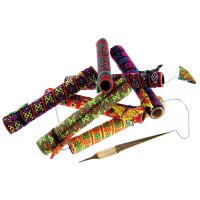In the year 1964 the French ethnologist Jacques Lemoine spent a number of weeks in the Saiyabouri province in North-West Laos. He had a tape recorder with him and during his stay among the Hmong people he recorded music time and time again. The Hmong are a number of indigenous tribes, who live in the mountains of South China, Laos, Vietnam and Thailand. One afternoon the ethnologist turned on his microphone exactly at that moment when two people began to converse using their Jew's harps.
This conversation has been documented in the online sound archive of the Parisian CREM (Centre for the Research of Ethnological Music) here:
The Jew's harps played on Jacques Lemoine´s recording are not simultaneously played in a duet, but rather one after the other. The first Jew's harp player listens to the second and then answers him. They send messages and sentences to one another, they translate words on their instruments. In order to transfer the spoken word to the Jew's harp, they follow in their mind the word they might sing and automatically imitate the speech melody with the Jew's harp. The pitch of the Jew's harp is based on the eight tones of the so called Miao-languages spoken by the Hmong.
And with the khen mouth organ, too, the Hmong encode words and entire sentences. The musical ethnologist Patrick Kersalé writes in the accompanying sleeve notes text to the CD "Music and Singing of the Hmong in Vietnam", that it is a case of complicated encoding which only those privy to it can understand. The Khen musicians also usually dance to their music. These dances are important, for example, at events such as funeral ceremonies. By means of the music played on the khen at funerals, they show the deceased the way to the next life and at the same time ensure that he can no longer find the way back into the world of the living.
The Hmong jew's harp ncas (the instrument known as Dan Moi) is used by boys and girls for courting purposes. Kersalé writes: „When all are asleep, the boy makes his way secretly at night to the girl's house. Discreetly, the boy goes to the wall of the house behind which the girl is sleeping. The walls of the Hmong houses are made of wood, with holes between the wood planks so that one can easily hear what is happening outside. The two start a conversation, whose words are partly simulated by use of the Jew's harp.
From time to time, the ethnmusicologist Tran Quang Hai, who is of French and Vietnamese extraction, has shown that the transfer of the spoken word to the Jew's harp can also form a source of inspiration for musicians from beyond the Hmong communities. In the documentary film "Mundton" he shows how the words "Hello, how are you. I'm very pleased to play the Jew's harp for you“ can be clearly played on the Jew's harp. In this manner, moreover, it is possible to simulate the sound of a robot. In any case, you can have great fun trying it out.









